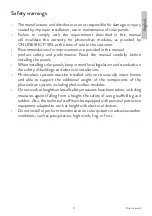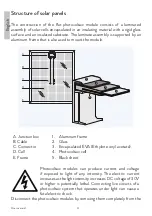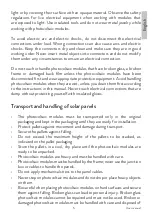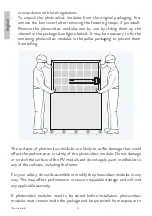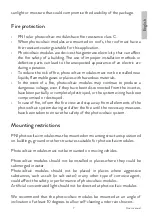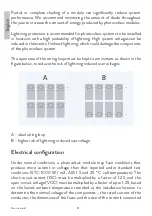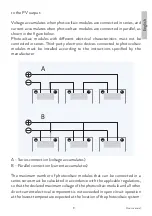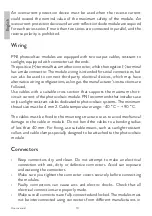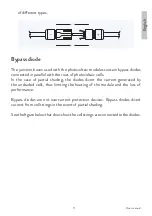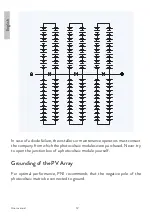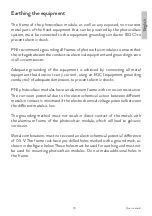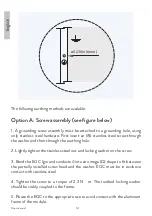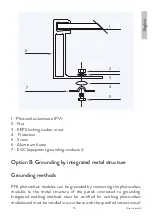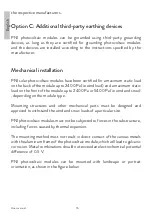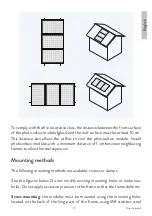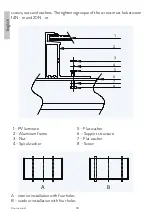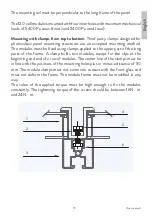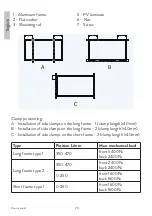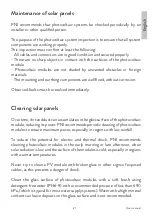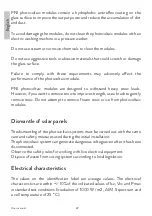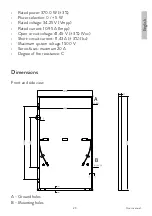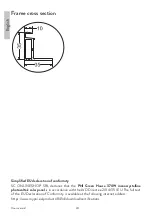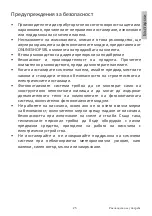
User manual
10
En
gli
sh
An overcurrent protection device must be used when the reverse current
could exceed the nominal value of the maximum safety of the module. An
overcurrent protection device and an anti-reflection diode module are required
for each series series if more than two series are connected in parallel, and the
reverse polarity is prohibited.
Wiring
PNI photovoltaic modules are equipped with two output cables, resistant to
sunlight, equipped with connectors at the ends.
The positive (+) terminal has a mother connector, while the negative (-) terminal
has a male connector. The module wiring is intended for serial connections, but
can also be used to connect third-party electrical devices, which may have
alternative wiring configurations, as long as the manufacturer’s instructions are
followed.
Use cables with a suitable cross section that supports the maximum short-
circuit current of the photovoltaic module. PNI recommends that installers use
only sunlight-resistant cables dedicated to photovoltaic systems. The minimum
thread size must be 4 mm2. Cable temperature range: -40 ° C ~ + 90 ° C.
The cables must be fixed to the mounting structure so as to avoid mechanical
damage to the cable or module. Do not bend the cables to a bending radius
of less than 40 mm. For fixing, use suitable means, such as sunlight-resistant
collars and cable clamps specially designed to be attached to the photovoltaic
module.
Connectors
• Keep connectors dry and clean. Do not attempt to make an electrical
connection with wet, dirty or defective connectors. Avoid sun exposure
and watering the connectors.
• Make sure you tighten the connector covers securely before connecting
the modules.
• Faulty connections can cause arcs and electric shocks. Check that all
electrical connections are properly made.
• Make sure all connectors are fully connected and locked. The modules must
not be interconnected using connectors from different manufacturers or
Summary of Contents for Green House 370W
Page 25: ...25 ONLINESHOP SRL...
Page 26: ...26 A B C D E 1 2 3 5 4 A B C D E 1 2 3 EVA 4 5...
Page 27: ...27 DC 30V...
Page 28: ...28...
Page 29: ...29...
Page 30: ...30 PNI C PNI...
Page 31: ...31 10 A B...
Page 32: ...32 A B STC 1000 W m2 AM 1 5 25 C ISC 1 25 VOC 1 25 PV...
Page 33: ...33 A B A B...
Page 34: ...34 PNI PNI 4 mm2 40 C 90 C 40 mm...
Page 35: ...35...
Page 36: ...36 PV Array PNI...
Page 37: ...37 EGC PNI EGC PNI 0 5V...
Page 38: ...38 0 236in 6mm A 1 M5 2 3 EGC EGC 4 2 3 N m...
Page 39: ...39 5 EGC 1 2 6 3 4 5 7 1 PV 2 3 KEPS 4 5 6 7 EGC...
Page 40: ...40 B PNI C PNI PNI 2400 Pa 2400 Pa 5400 Pa PNI...
Page 41: ...41 0 5 V PNI 10 cm...
Page 42: ...42 1 M8 14N m 20N m 1 2 3 4 5 6 7 8...
Page 43: ...43 1 PV 2 3 4 5 6 7 8 A B B 120 5400 Pa 2400 Pa 50 mm 16N m 24N m...
Page 44: ...44 6 5 2 4 3 1 1 2 3 5 PV 6 7 L L L L L A B C A 1...
Page 46: ...46 PNI PNI PV PH6 9 690 kPa PNI...
Page 48: ...48 A B A B Sectiune transversala a cadrului...
Page 231: ......
Page 232: ......



